
Making these adorable infant caps is one of the easiest projects on this site. And a very useful one, too!
I love this infant cap ! Not only are these hats easy to make, but they are super quick to make, too. Make one to match each and every outfit in your baby's layette!
When my daughter was in her infant stages I used this kind of baby hat like crazy. You could say I was baby hat crazy! Haha! They are great for fall and winter months, and even a crisp spring morning.
Don't be afraid to get creative! Go out and find some really bright and beautiful unique fabrics. Don't be afraid to shy away form the traditional pastel pink and blue.Don't get me wrong, those are cute colors. But you could make the most wonderful and unique baby hats with bold and bright print. I also recommend using a light jersey knit as it will stretch to accommodate different sizes.
The pattern (there are two styles!) I have provided is suited mostly for a newborn, but you can it slightly to fit a older baby. And yes there are two styles of baby hats that you can make form this pattern. Well, kinda of three.
You can make the standard, folded brim hat. These are very much the same style as the little caps you bring home from the hospital (except with much more style).
You can also make a super easy to sew rough edge infant cap. Here's the thing about jersey cotton - you can completely avoid sewing a hem on the edges and it will not fray. I mean, you could just sew a sort of decorative seam along the edge if you'd like. But seriously, just leave the raw edges and it will have that little bit of natural and rustic feel.
Lastly, you can make a cute little stocking hat with or without a knotted top (my fave!).
To make any of these you really only need some good size fabric scraps. Like, less than a fat quarter. You could even make them out of old T-shirts.
Let's Begin Making Some Baby Hats, Shall We?
Step One: Start by printing out the infant cap pattern
onto standard white paper. Trim the pieces form the paper.
Step Two: Lay out the fabric (you will only need about 1.5 square feet of fabric at most) on your workspace. The fabric should be folded in two so that when you cut the pattern piece you will have two equal pieces. Pin the pattern to the fabric (or use pattern weights) and use thepattern as a guideline to cut the pieces from the fabric.
Step Three: With right sides together and a 1/4" seam allowance sew the outer edges of the hat.
P.S. I used my serger for the hat pictured below. NO WORRIES at all if you don't have a serger. A regular straight stitch will work very well, probably even better!
From here you have to decide which kind of hat you want to make! Do you want to make the rustic raw edge jersey cotton baby hat? Or maybe the folded over infant cap? And don't forget about the stocking infant cap!
For the raw edge infant cap you're already done. All you need to do is turn the fabric right side out and give it a little bit of a press with a hot iron. It's ready to wear!
For a Stitched Folded Brim Baby Cap...
With the hat still facing wrong side out, fold the bottom edge up to meet where the horizontal line crosses on the baby hat pattern. Pin it in place and iron the bottom edge flat. Stitch across the fabric about a 1/4" from where the raw edge lays.
Here is what it look like if you turn the hat right side out after stitching.
You could use it just like this if you like the look, or fold the bottom edge up yet again.
For A Raw Edge Stocking Hat
This is my personal fave! These are just soooo uber cute. So like above you'll be sewing a seam along the outer edges with a 1/4" seam allowance. These hats are best left with a raw edge, or with the bottom edge folded under by only 1/2", pressed an sewn in place.
When you are done sewing fold the hat right side out press the hat with a hot iron and wear as is, or tie the tippity top into a little knot.
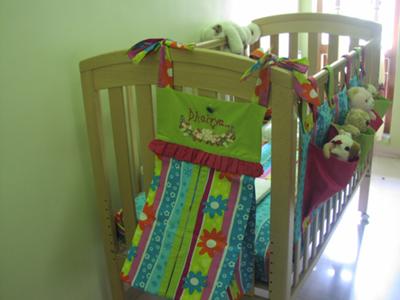
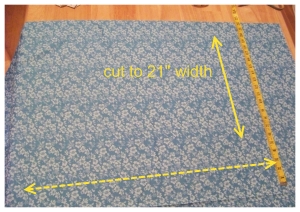 Begin by laying your fabrics on a flat work surface so they facing right sides together. The average width of the sling should be about 20-24". The width section is where your baby will actually sit. So you have the choice of making it a bit roomier or smaller depending on the size of your babe. I like mine to be about 20" wide so I cut my fabric to 21" in width (to allow for seam allowance). After cutting, your fabrics should be 20-24" wide by 62" (to allow for seam allowance).
Begin by laying your fabrics on a flat work surface so they facing right sides together. The average width of the sling should be about 20-24". The width section is where your baby will actually sit. So you have the choice of making it a bit roomier or smaller depending on the size of your babe. I like mine to be about 20" wide so I cut my fabric to 21" in width (to allow for seam allowance). After cutting, your fabrics should be 20-24" wide by 62" (to allow for seam allowance).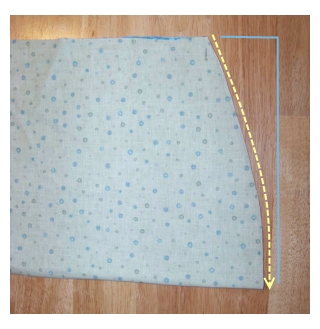
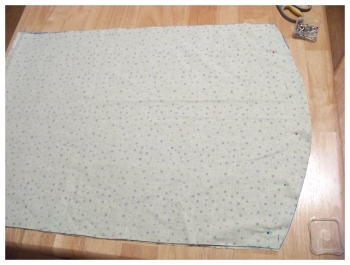

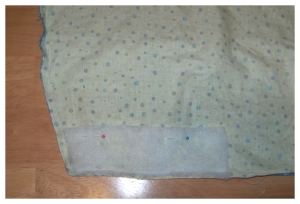
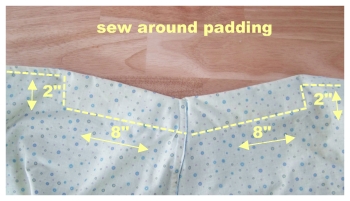
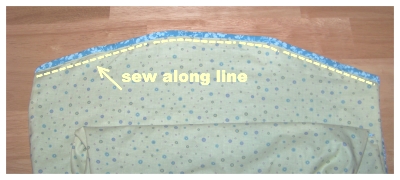
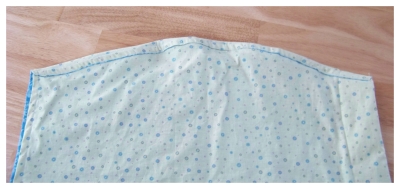
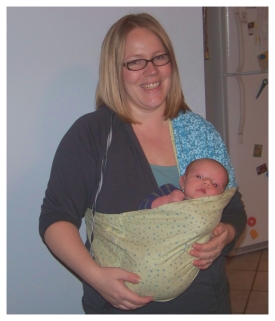
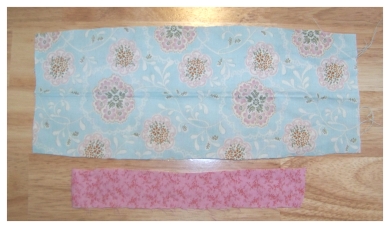
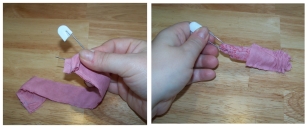 Using a hot clothes iron fold one edge (left or right) of the "front of headband" piece over by around 1/4-1/2" and iron in place. Fold this piece in half lengthwise with right sides facing and sew a seam along the outer edge with a 1/4" seam allowance. On the second (back of headband) piece sew a lengthwise seam also with a 1/4" seam allowance. Both pieces will form a tube of sorts. Pull both pieces right side out. A trick I use to make turning easy is to insert a safety pin in one end and push it through to the other end. Then, simply pull it out the end.
Using a hot clothes iron fold one edge (left or right) of the "front of headband" piece over by around 1/4-1/2" and iron in place. Fold this piece in half lengthwise with right sides facing and sew a seam along the outer edge with a 1/4" seam allowance. On the second (back of headband) piece sew a lengthwise seam also with a 1/4" seam allowance. Both pieces will form a tube of sorts. Pull both pieces right side out. A trick I use to make turning easy is to insert a safety pin in one end and push it through to the other end. Then, simply pull it out the end.
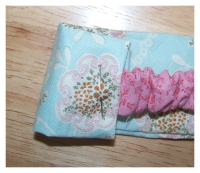 First things first, pull the end of the elastic out of the opposite end of the fabric so that you are scrunching the fabric up around the elastic a bit. When you get the desired length of elastic pin it in place. You can choose to trim the elastic as well if need be.
First things first, pull the end of the elastic out of the opposite end of the fabric so that you are scrunching the fabric up around the elastic a bit. When you get the desired length of elastic pin it in place. You can choose to trim the elastic as well if need be.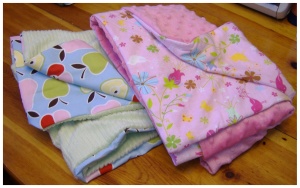 If your truly are a complete sewing newbie, you may want to forgo the stretchy fleece fabrics and go with a simple flannel or cotton!
If your truly are a complete sewing newbie, you may want to forgo the stretchy fleece fabrics and go with a simple flannel or cotton!

 Making these adorable infant caps is one of the easiest projects on this site. And a very useful one, too!
Making these adorable infant caps is one of the easiest projects on this site. And a very useful one, too!





 Supply List:
Supply List:





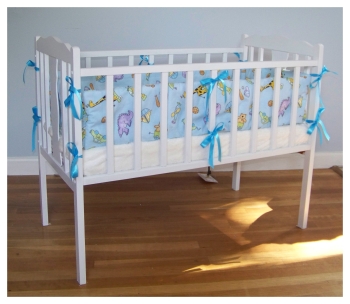
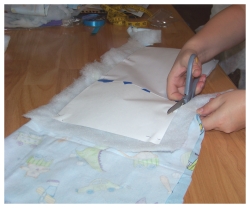 Lay the fabric down folded with the right sides (the front) facing inward. Now lay a sheet of cotton batting over this. The cotton batting can be whatever weight suits you. It all depends on how thick you want your bumpers to be.
Lay the fabric down folded with the right sides (the front) facing inward. Now lay a sheet of cotton batting over this. The cotton batting can be whatever weight suits you. It all depends on how thick you want your bumpers to be.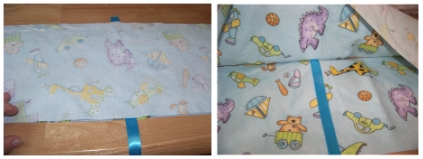
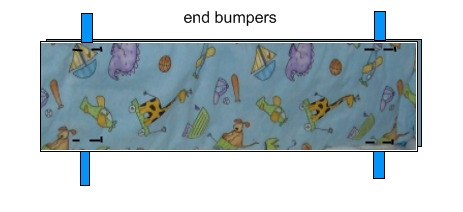
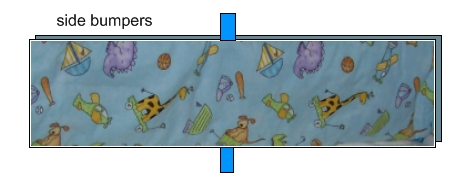
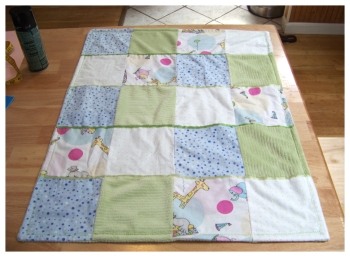
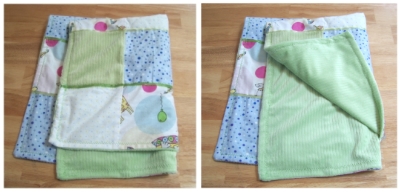
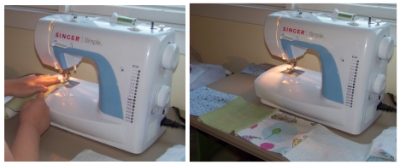
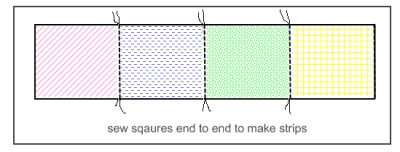
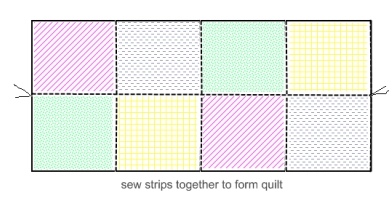
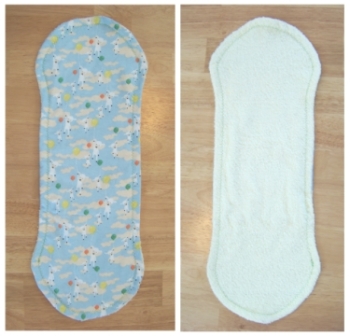 I first created this burp cloth pattern on newspaper, and later traced the pattern onto separate paper and transferred it to the computer for you all to use. The pattern is now available as an instan file. Simply print the file, tape the pieces together and start your sewing project.
I first created this burp cloth pattern on newspaper, and later traced the pattern onto separate paper and transferred it to the computer for you all to use. The pattern is now available as an instan file. Simply print the file, tape the pieces together and start your sewing project.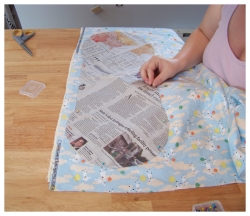
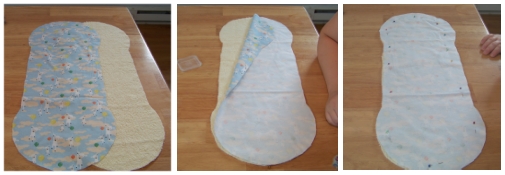
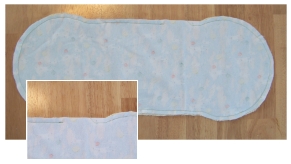
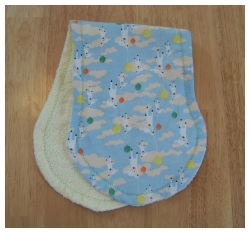
 Supplies List:
Supplies List:


